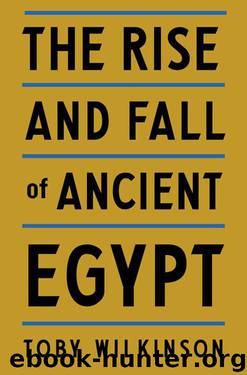The Rise and Fall of Ancient Egypt by Toby A. H. Wilkinson

Author:Toby A. H. Wilkinson
Language: eng
Format: mobi, epub
Tags: Ancient, Egypt, General, Egypt - History - 332-30 B.C, Civilization, Social History, Egypt - History - To 332 B.C, History
ISBN: 9780553805536
Publisher: Random House Publishing Group
Published: 2011-03-14T10:00:00+00:00
Statues of Ramesses II fronting his temple at Abu Simbel WERNER FORMAN ARCHIVE
After Ipetsut, Luxor, and Abu Simbel, Ramesses’s greatest project was his own mortuary temple on the west bank of the Nile at Thebes. The most ambitious monument of its kind since the reign of Amenhotep III, “Ramesses United with Thebes” (known today as the Ramesseum) covered an area of more than eleven and a half acres. Quite unashamedly, every inch of the temple was given over to texts, reliefs, and statuary celebrating the king. Beyond the first great gateway, decorated with scenes of the Battle of Kadesh, the first courtyard was dominated by a series of huge pillars along the north side, each of which had a gigantic statue of Ramesses in front of it. Facing them, on the south side, was a portico and balcony, where the king could appear to his loyal followers on high days and holidays. Beyond a second gateway, bearing yet more battle reliefs, lay a second court, likewise adorned with colossal statues of Ramesses. Dwarfing even these, a vast granite colossus once stood next to the second gateway, until an earthquake felled it in antiquity. Its shattered remains, carved deeply with the king’s throne name, Usermaatra (corrupted to Ozymandias in Greek), inspired the most famous critique of absolute power in the English language.
The Ramesseum, perhaps more than any other monument, summed up its owner’s unrivaled status not just in spiritual but also in temporal matters. Surrounding the temple on all sides, vast storerooms and granaries provided storage for a significant part of Egypt’s wealth. It would have taken 350 boatloads (a quarter of a million sacks) of grain to fill the granaries completely, enough to support the inhabitants of a medium-size city (such as Thebes) for a year. In effect, the Ramesseum acted as Upper Egypt’s reserve bank. Both practically and symbolically, the nation’s wealth was under royal control. With such vast resources at his disposal, Ramesses could afford to indulge his obsession with monumentality, from the vast colossi of Abu Simbel to the majestic courts of Thebes. Well might he have uttered the immortal words of Shelley’s poem:
“My name is Ozymandias, king of kings:
Download
The Rise and Fall of Ancient Egypt by Toby A. H. Wilkinson.epub
This site does not store any files on its server. We only index and link to content provided by other sites. Please contact the content providers to delete copyright contents if any and email us, we'll remove relevant links or contents immediately.
Whiskies Galore by Ian Buxton(41880)
Introduction to Aircraft Design (Cambridge Aerospace Series) by John P. Fielding(33064)
Rewire Your Anxious Brain by Catherine M. Pittman(18553)
Craft Beer for the Homebrewer by Michael Agnew(18141)
Cat's cradle by Kurt Vonnegut(15186)
Sapiens: A Brief History of Humankind by Yuval Noah Harari(14252)
Leonardo da Vinci by Walter Isaacson(13184)
The Tidewater Tales by John Barth(12608)
Thinking, Fast and Slow by Kahneman Daniel(12079)
Underground: A Human History of the Worlds Beneath Our Feet by Will Hunt(12024)
The Radium Girls by Kate Moore(11921)
The Art of Thinking Clearly by Rolf Dobelli(10224)
A Journey Through Charms and Defence Against the Dark Arts (Harry Potter: A Journey Throughâ¦) by Pottermore Publishing(9232)
Mindhunter: Inside the FBI's Elite Serial Crime Unit by John E. Douglas & Mark Olshaker(9203)
Tools of Titans by Timothy Ferriss(8218)
Wonder by R. J. Palacio(8010)
Turbulence by E. J. Noyes(7936)
Change Your Questions, Change Your Life by Marilee Adams(7635)
Nudge - Improving Decisions about Health, Wealth, and Happiness by Thaler Sunstein(7615)
